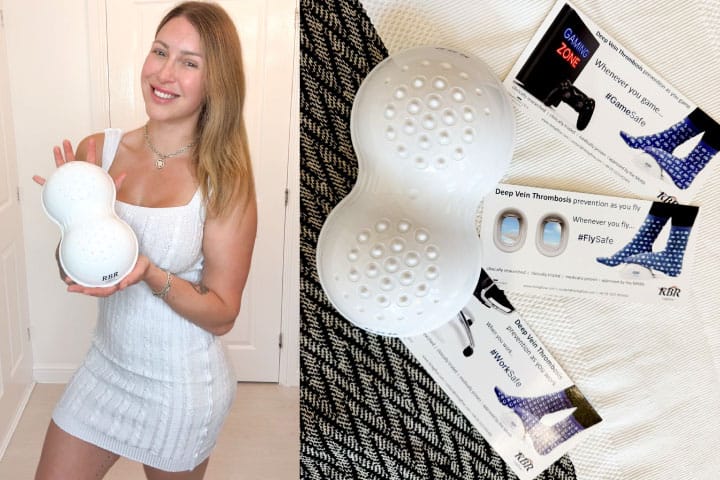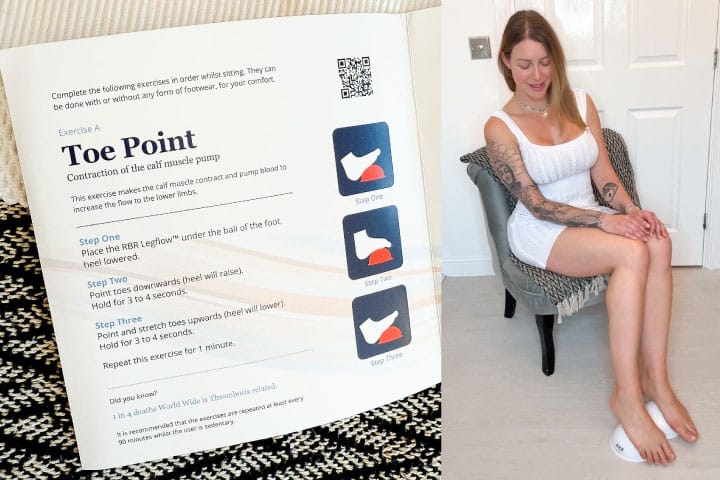If you have ever experienced perpetually cold hands and feet, or felt a persistent tingling sensation in your limbs, these may be more than just minor annoyances. They could be subtle, or not-so-subtle, hints from your body that your circulation isn’t quite up to par…

Good blood circulation is fundamental to overall health as our circulatory system is like the body’s own road network, delivering oxygen, nutrients and hormones to every cell, tissue, and organ, as well as carrying away waste products. When this system isn’t running efficiently, various parts of our body can suffer as a result of poor circulation.
The good news? Many instances of sluggish circulation can be improved with simple, natural strategies right from the comfort of your very own home. But first, let’s learn how to spot the warning signs.
The Telltale Signs: How To Spot Poor Circulation
Identifying the symptoms of poor circulation early can help you take action before more serious issues arise. So keep an eye out for these common warning signs…

- Cold Hands and Feet: This is perhaps the most classic symptom of poor circulation. If your extremities are consistently colder than the rest of your body, even in mild temperatures, it could indicate reduced blood flow to those areas.
- Numbness or Tingling / Pins and Needles: A frequent feeling of “pins and needles” or a loss of sensation in your hands, feet or limbs often points to insufficient blood reaching the nerves.
- Swelling in Extremities / Edema: Poor circulation can lead to fluid retention, especially in the ankles, feet and legs. This swelling is often worse at the end of the day.
- Muscle Cramps & Pain: Muscles require a steady supply of oxygenated blood. When circulation is poor, particularly during or after activity, muscles can ache, cramp or feel heavy due to a buildup of waste products. This is often most noticeable in the legs.
- Skin Discoloration: If your skin appears pale, bluish (cyanosis), or even reddish-purple, especially in the fingers, toes, or lower legs, it could be due to a lack of oxygenated blood.
- Slow Healing Wounds: Cuts, scrapes or sores on your skin, especially on your feet or legs, that take an unusually long time to heal can be a red flag. Good blood flow is essential for the body’s repair processes.
- Fatigue: Reduced oxygen delivery to your muscles and organs can leave you feeling unusually tired and lacking energy.
- Hair Loss and Brittle Nails: Your hair and nails need nutrients delivered by blood. Poor circulation can lead to hair loss, thinning hair and brittle nails.
- Memory Problems and Dizziness: While less common and often linked to more severe cases, reduced blood flow to the brain can sometimes manifest as lightheadedness, dizziness or difficulties with concentration and memory.

How To Naturally Boost Your Circulation At Home
If you’ve noticed some of these symptoms, don’t despair! Many lifestyle changes can significantly improve your blood flow. Here are a few tips on how you can naturally boost your circulation at home:
- Get Moving – Regular Exercise is Key!: This is arguably the most effective natural booster. Exercise strengthens the heart and lungs, improves blood vessel elasticity and encourages better blood flow throughout your body.
- Aim for: At least 30 minutes of moderate-intensity aerobic exercise most days of the week, you may like to try brisk walking, jogging, cycling or swimming.
- Incorporate: Strength training helps to build muscle, which also aids in blood return to the heart.
- Don’t forget: Even light activities like stretching, yoga or simply moving around every hour if you have a sedentary job can make a difference.
- Stay Hydrated: Water is crucial for maintaining blood volume and consistency. Dehydration can cause blood to thicken, making it harder for your heart to pump.
- Aim for: 8 glasses of water daily, more if you’re active or in a hot climate. Herbal teas also count!
- Eat a Heart-Healthy Diet: What you eat directly impacts your vascular health.
- Focus on: Fruits, vegetables, whole grains, lean proteins, and healthy fats such as avocado, nuts, seeds and olive oil.
- Include foods rich in:
- Nitrates: (e.g., beetroot, leafy greens) which the body converts to nitric oxide, a compound that helps relax and widen blood vessels.
- Omega-3 Fatty Acids: (e.g., fatty fish like salmon, flaxseeds, chia seeds) known for their anti-inflammatory properties and ability to reduce blood clotting.
- Antioxidants: (e.g., berries, citrus fruits) to protect blood vessels from damage.
- Reduce: Saturated and trans fats, excessive sugar, and high sodium intake, all of which can negatively impact blood vessel health and contribute to inflammation.
- Maintain a Healthy Weight: Carrying excess weight, particularly around your abdomen, can put extra strain on your circulatory system and increase your risk of circulation problems.
- Quit Smoking: Smoking is incredibly detrimental to circulation. It damages blood vessel walls, thickens blood and reduces oxygen delivery. Quitting is one of the best things that you can do for your cardiovascular health.
- Manage Stress: Chronic stress can constrict blood vessels and increase blood pressure. Practices such as meditation, deep breathing exercises, yoga or spending time in nature can help to relax your body and improve blood flow.
- Elevate Your Legs: If you experience swelling in your feet and ankles, elevating your legs above your heart for 15-20 minutes a few times a day can help to drain accumulated fluid and improve venous return.
- Consider Compression Stockings: For persistent leg swelling or discomfort, mild compression stockings can help to promote blood flow back to the heart.
- Warm Baths/Showers & Massage: Heat can dilate blood vessels, promoting blood flow. A warm bath or shower can be very relaxing. Gentle massage can also help to stimulate circulation, especially in cold or stiff areas.

When To Seek Medical Advice
While these home remedies can be very effective for mild to moderate circulation issues, it’s crucial to consult a doctor if your symptoms are severe or suddenly worsen, you experience persistent pain, numbness, or swelling, you have coldness, pale skin, or ulcers that don’t heal, especially on your feet, or if you have underlying health conditions like diabetes, heart disease, or kidney disease, as these can significantly impact circulation.
RBR Legflow DVT Prevention Device
A simple and highly effective piece of healthcare equipment that I love is the RBR Legflow device which actively increases the bodies own blood flow to the lower limbs as you go about your day. With no need for dying batteries, being tied to a socket or additional specialist tools or equipment, you simply pop your feet onto it whenever you find the time.
Hailed as the world’s only clinically researched and clinically trialled MHRA accredited DVT prevention device, it’s highly effective for moments when you experience long periods of inactivity; working in an office or from home, on a flight, if you are hospitalised, online gaming, recovering from an operation or simply watching television can all become the perfect moments to boost your circulation.
The compact medical device simply sits on the floor, discreetly under foot, and features two round domes with protruding nodules to accommodate both of your feet at once. Manufactured using leading antimicrobial technology, all materials used in the legflow device are reassuringly approved by the FDA and EPA for peace of mind.

I personally suffer from cold, tingling extremities which often turn numb and discoloured and find this lightweight device perfect for whilst I’m working from home or watching television. It’s incredibly sturdy, lightweight, durable and easy to use, as its been designed to enable people of all ages to perform a range of simple exercises at home, or away, to help to prevent deep vein thrombosis. Clinically tested, it significantly increases blood flow to the lower limbs by over ten-fold, painlessly and proficiently which has made such an enormous difference to my day.
The device comes already assembled in one smooth, fluid piece, with easy to follow instructions which enable you to perform three simple exercises: Toe Point to contract the calf muscle pump, Arch Press to compress the plantar reservoir and Toe Raise for the muscle relaxation for inflow to the plantar reservoir. Essentially, you simply raise and lower your toes in a series of positions on the domes to target the ball, arch and heel of the foot, with the pain-free contact naturally stimulating your circulation.
So don’t let poor circulation scare or slow you down anymore. By understanding the warning signs to look out for, and embracing natural strategies to encourage blood flow from home, you can give your circulatory system the boost it needs to keep you feeling vibrant and healthy from head to toe!
www.rbrlegflow.com
Facebook: /rbractive
X: @rbractive
Instagram: @rbrlegflow
